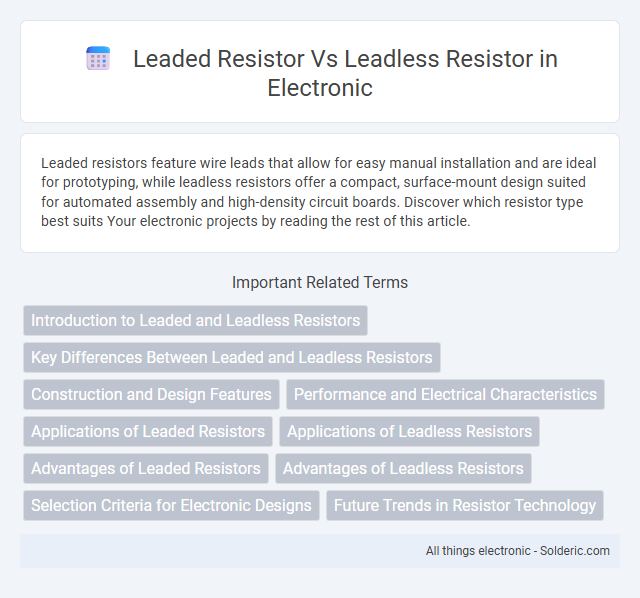Leaded resistors feature wire leads that allow for easy manual installation and are ideal for prototyping, while leadless resistors offer a compact, surface-mount design suited for automated assembly and high-density circuit boards. Discover which resistor type best suits Your electronic projects by reading the rest of this article.
Comparison Table
| Feature | Leaded Resistor | Leadless Resistor |
|---|---|---|
| Design | Has wire leads for through-hole mounting | No wire leads, surface mount technology (SMT) |
| Mounting Type | Through-hole | Surface mount |
| Size | Larger footprint | Compact and smaller size |
| Assembly | Manual or machine insertion required | Automated pick-and-place assembly |
| Thermal Performance | Better heat dissipation due to leads | Lower heat dissipation, depends on PCB design |
| Applications | Prototyping, high power, and through-hole boards | High-density PCB, modern electronics, compact devices |
| Cost | Generally lower unit cost but higher assembly cost | Higher unit cost but reduced assembly cost |
| Reliability | More robust mechanical connection | Less mechanical stress, sensitive to solder joint quality |
Introduction to Leaded and Leadless Resistors
Leaded resistors feature axial wire leads for through-hole mounting, providing robust mechanical support and ease of manual soldering in prototyping and repair applications. Leadless resistors, also known as surface-mount resistors (SMD), lack wire leads and are designed for automatic placement on PCB pads, enabling higher circuit density and improved performance in compact electronic devices. The choice between leaded and leadless resistors depends on factors like assembly process, board design, and size constraints.
Key Differences Between Leaded and Leadless Resistors
Leaded resistors feature wire leads for through-hole mounting, enabling easy installation and removal in prototyping or repairs, while leadless resistors are surface-mount devices (SMD) designed for automated assembly and compact circuit designs. Leaded resistors typically have higher power ratings and withstand mechanical stress better, whereas leadless resistors offer superior high-frequency performance and reduced parasitic inductance. The choice between leaded and leadless resistors depends on application requirements like board space, manufacturing process, and electrical characteristics.
Construction and Design Features
Leaded resistors feature wire leads extending from their ceramic or metal oxide body, allowing easy through-hole mounting and excellent mechanical stability, ideal for prototyping and high-stress environments. Leadless resistors, or chip resistors, have a compact, rectangular design with metalized end caps for surface-mount technology, optimizing space and enabling high-density PCB layouts. Your choice between these resistor types depends on assembly requirements, durability, and circuit design constraints.
Performance and Electrical Characteristics
Leaded resistors typically offer better mechanical stability and heat dissipation due to their wire leads, which can improve performance in high-power applications. Leadless resistors feature smaller size and lower inductance, resulting in superior high-frequency response and reduced parasitic effects in compact circuits. Your choice between leaded and leadless resistors should depend on specific electrical characteristics such as tolerance, thermal resistance, and the intended frequency range of your application.
Applications of Leaded Resistors
Leaded resistors are commonly used in applications requiring easy manual assembly and repair, such as prototyping, through-hole PCB designs, and high-voltage circuits due to their superior heat dissipation. Their axial or radial leads facilitate secure connections in power supplies, audio equipment, and industrial machinery where mechanical stability is essential. Leaded resistors are preferred in environments demanding robust physical durability and straightforward replacement processes.
Applications of Leadless Resistors
Leadless resistors are primarily used in high-density, surface-mount technology (SMT) applications where space-saving and automated assembly are crucial, such as in smartphones, medical devices, and aerospace electronics. Their compact size and excellent reliability under harsh environmental conditions make them ideal for precision circuit boards requiring minimal parasitic inductance and capacitance. You benefit from enhanced performance and durability in complex electronic designs by choosing leadless resistors over traditional leaded variants.
Advantages of Leaded Resistors
Leaded resistors offer advantages such as easier handling and soldering during manual assembly, providing secure mechanical connections and improved durability in high-vibration environments. Their axial leads allow for flexible placement on through-hole PCBs, ensuring reliable performance in circuits requiring robust electrical and thermal stability. You benefit from leaded resistors' compatibility with traditional manufacturing techniques and enhanced repairability compared to leadless alternatives.
Advantages of Leadless Resistors
Leadless resistors offer significant advantages including enhanced performance at high frequencies due to reduced lead inductance and parasitic capacitance. Their compact size enables higher component density on printed circuit boards, improving overall device miniaturization and reliability. These resistors also facilitate automated assembly processes, increasing manufacturing efficiency and reducing production costs.
Selection Criteria for Electronic Designs
Leaded resistors offer advantages in prototyping and high-power applications due to their ease of handling and superior heat dissipation, making them ideal for through-hole PCB designs requiring mechanical stability. Leadless resistors, such as surface-mount resistors (SMT), provide better performance in compact, high-density electronic circuits due to smaller size, reduced parasitic inductance, and superior frequency response. Selection criteria for electronic designs hinge on factors like assembly technology, space constraints, thermal management, and electrical performance requirements to optimize efficiency and reliability.
Future Trends in Resistor Technology
Future trends in resistor technology emphasize the shift from leaded resistors to leadless resistors due to environmental regulations and demand for miniaturization. Leadless resistors offer improved thermal performance and better reliability in high-frequency applications, supporting advances in compact electronic devices. Your designs will benefit from enhanced durability and reduced environmental impact by adopting leadless resistor technology.
leaded resistor vs leadless resistor Infographic

 solderic.com
solderic.com